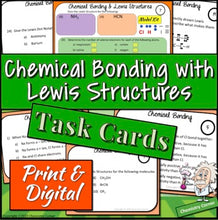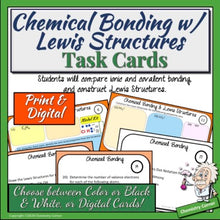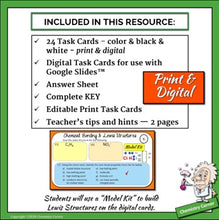The task cards included in this resource will fit nicely with your bonding unit. There is a good variety of question types. Using digital task cards, students will circle answers, check mark answers, give short answers, drag and drop answers, and build Lewis Structures using a “model kit”. You will also find included on the teacher’s tips pages suggestions for several different ways to use the task cards such as; classroom work, quiz, review, and several more.
Print & Digital Task Cards Included!
Students will compare ionic and covalent bonds and compounds. Identify ionic and covalent compounds based on compound formula and electronegativity differences. Students will also draw Lewis Structures for atoms, monatomic ions, polyatomic ions, molecular compounds, and ionic compounds.
Included in This Resource:
* 24 task cards (with 36 separate questions & problems) Choose between color or black & white
* Digital task cards for use with Google Slides™ - 14 slides
* Editable task cards for the print task cards
* Teacher’s Tips Pages (two pages of strategies for using the bonding task cards, pictures of completed digital task cards (2)
* Student Answer Sheets
* Answer Key
Lesson Objectives:
* Define molecules, molecular formula, and formula units
* Classify bonding type according to electronegativity differences
* Determine bond type based on compound formula
* Determine Lewis Dot Notation, and create Lewis Structures for atoms, monatomic ions, polyatomic ions, molecular compounds, and ionic compounds
Prior Knowledge:
An understanding of electronegativity and electronegativity differences, covalent bonding and ionic bonding, and Lewis Structures
Teacher Prep Time: prep of task cards - then use them year after year!
This lesson is appropriate for grades 9-12 chemistry
This will be a lesson you will want to use year after year!
Chemistry Corner
*************************************************************************************
Check out these other products that you may be interested in:
Let’s Talk Lewis Structures Task Cards
Chemical Bonding: An Introductory Lesson on Types of Chemical Bonds
Chemical Bonding: Ionic Bonds & Ionic Compounds
Chemical Bonding: Covalent Bonds & Lewis Structures
Chemical Bonding: Metallic Bonds
Chemical Bonding: The VSEPR Theory and Molecular Geometry
Chemistry Task Cards for the Year – A Growing Bundle
High School Chemistry Year Curriculum: A Growing Bundle
*************************************************************************************
Chemistry Corner’s PowerPoints are perfect for the flipped classroom. However, please read the Copyright Terms below before using them as such. Thanks!
LICENSING TERMS: By downloading this product, you own a license for one teacher only for personal use in your classroom. Licenses are non-transferable, meaning they cannot be passed from one teacher to another. No part of this resource is to be shared with colleagues or used by an entire grade level, school, or district without purchasing the proper number of licenses. I you are a coach, principal or district interested in transferable licenses to accommodate yearly staff changes, please contact Chemistry Corner.
COPYRIGHT TERMS: ©Chemistry Corner. Please note – all material included in this resource belongs to Chemistry Corner. By downloading, you have a license to use the material, but you do not own the material. This resource, or any portion of this resource, may not be uploaded to the internet in any form, including classroom/personal websites or network drives, unless the site is password protected and can only be accessed by students—no other teachers or anyone else on the internet.






